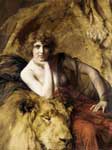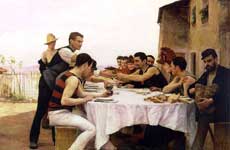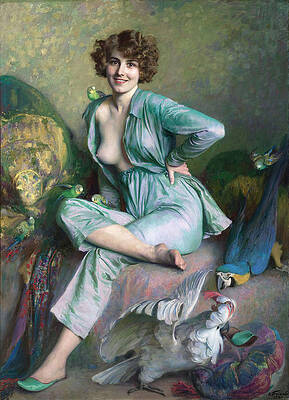Émile Friant
Paintings
The Familiar Birds
Journey to Infinity




Fine Art Prints | Greeting Cards | Phone Cases | Lifestyle | Face Masks | Men's , Women' Apparel | Home Decor | jigsaw puzzles | Notebooks | Tapestries | ...
Émile Friant (16 April 1863 – 9 June 1932) ) was a French artist. Friant was born in the commune of Dieuze. He would later be forced to flee to Nancy by to the encroachment of the Kingdom of Prussia's soldiers. His paintings were featured throughout his lifetime at the Salon, until a tragic fall led to his demise in 1932.
Friant created works in charcoal, oil, and other media. He also used photographs to prepare finished paintings.
Early life
Le petite barque
Friant was born in the commune of Dieuze in 1863.[3] His father was a locksmith and mother a dressmaker. The wife of a chemist, Madame Parisot would hire the wife of Émile Friant's father to design custom clothing. The Parisots took an early interest in the young Friant and treated him maternally, as they were without children of their own.[4]
With the defeat of the Second French Empire at hand, as part of the then-ongoing Franco-Prussian War, Dieuze was no longer under state control.[5] Intensely distressed by this, Parisot intended to leave the commune for Nancy, but died shortly before having the chance. In 1871,[3] Madame Parisot fled with Friant to Nancy; his biological family would follow later.[5]
Friant was to sent to the lycée to learn Latin, as Madame Parisot intended for him to follow in her husband's footsteps and become a chemist.[5][6] Meanwhile, friends of his biological father had suggested sending him to a municipal school of art because of his skill with the brush. Because of his poor work at the lycée, Friant requested permission to leave and focus on his art. His father agreed, and the young Friant was placed under the guide of a private tutor who would arrange his academic work so that time remained for painting. Under the guidance of Louis-Théodore Devilly, director of a school in Nancy and a proponent of realism,[6] Friant learned the art of still life and landscape painting.[7]
Friant painted Le petit Friant at the age of 15. It was exhibited in Nancy and quickly became the center of public intrigue. The municipal council granted him permission to travel to Paris a year later. There, he studied under Alexandre Cabanel, who tutored him in creating oil sketches of historical works. Friant, becoming disenchanted by the academic style of the atelier method, returned to Nancy.[6][7]
The Salon
Madame Coquelin's portrait
In 1882, Aime Morot, a friend of Friant, encouraged him to debut two of his works at the Salon: The Prodigal Son and Studio Interior. The following year, Friant took second place in the Prix de Rome and again presented at the Salon. At his next two Salon presentations, spanning from 1883 to 1884, he won third-class and second-class honors respectively. He would form a lasting friendship with the actors Ernest and Benoit Coquelin. With the grant he received from the Salon of 1886, Frian traveled to and studied in the Netherlands. His portrait of the Coquelins' mother reflects the influence of that trip.[6]
Later life
Friant was appointed a professor of painting in 1923 at the École des Beaux-Arts in Paris, France, promoted to the position of commander in the Legion of Honor, and made a member of the Institut de France. In 1932, Friant fell to his death in Paris.[8]
Paintings
Le travail du lundi, 1884. Oil on wood panel. Musée des beaux-arts de Nancy, France.
Jeune Nancéenne dans une paysage de neige (Young lady from Nancy in snow landscape), 1887. Oil on canvas, 46 x 37 cm. Musée des beaux-arts de Nancy, France.
La Toussaint (All Saints' Day), 1888. Oil on canvas, 254 x 334 cm. Musée des beaux-arts de Nancy, France.
Par lui-même (self-portrait). 1895. Oil on wood panel. Musée des beaux-arts de Nancy, France.
Femme avec un lion (Lady with lion).
L'echo de la Forêt, Petit Palais, Paris, France. Exposed at the Salon de la Société nationale des Beaux-Arts, 1911.
Guillaume Dubufe (1835-1909) à son chevalet, no date. Musée d'Orsay, Paris, France.
Portrait de M. Émile Hinzelin, 1908. Musée d'art moderne et contemporain, Strasbourg, France.
L'oiseau blessé, date unknown. Exhibited at the Salon de Paris.
Footnotes
Death certificate on geneanet.org (the creation of an account is required before consulting).
http://www.daheshmuseum.org/collection/detail.php?object=friante_3
Thomson 2004, p. 183
Hamerton 1894, p. 675
Hamerton 1894, p. 676
McIntosh 1997, p. 1
Hamerton 1894, p. 677
McIntosh 1997, p. 6
Bibliography
Hamerton, Philip Gilbert (1 December 1894), Types Of Contemporary Painting. XII. Cast Shadows, By Emile Friant 16 (6), Scribner's Magazine, retrieved 15 November 2009
Template:Citation journal
Thomson, Richard (2004), The Troubled Republic, Yale University Press, ISBN 978-0-300-10465-3, retrieved 15 November 2009
Beaupre, Norman. (2010) The Man With the Easel of Horn - The Life and Works of Emile Friant. Llumina Press (Biographic novel by a French Art scholar. Synopsis at http://nrbeaupre.com/writings/easel-of-horn.html)
----
Fine Art Prints | Greeting Cards | Phone Cases | Lifestyle | Face Masks | Men's , Women' Apparel | Home Decor | jigsaw puzzles | Notebooks | Tapestries | ...
----
Artist
A - B - C - D - E - F - G - H - I - J - K - L - M -
N - O - P - Q - R - S - T - U - V - W - X - Y - Z
Retrieved from "http://en.wikipedia.org/"
All text is available under the terms of the GNU Free Documentation License




